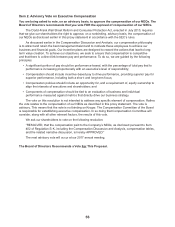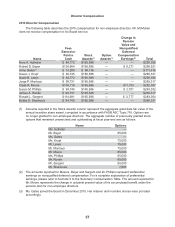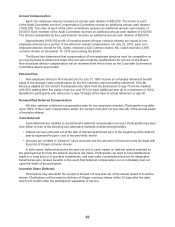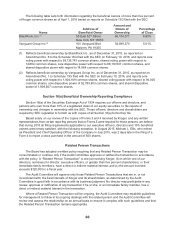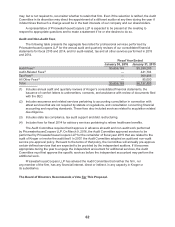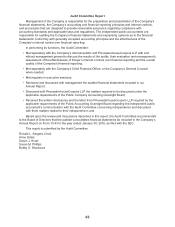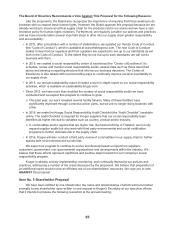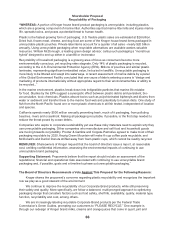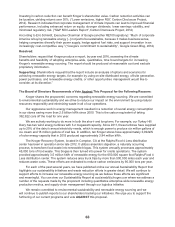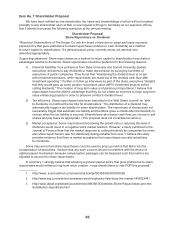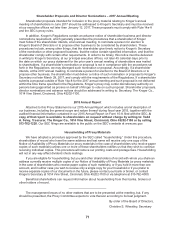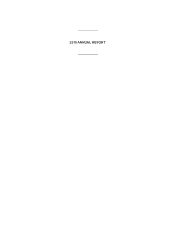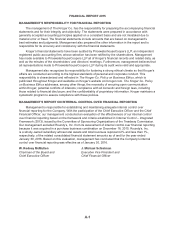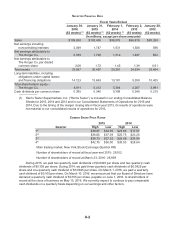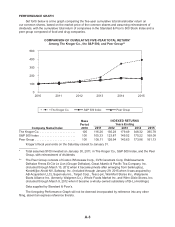Kroger 2015 Annual Report Download - page 68
Download and view the complete annual report
Please find page 68 of the 2015 Kroger annual report below. You can navigate through the pages in the report by either clicking on the pages listed below, or by using the keyword search tool below to find specific information within the annual report.
66
Shareholder Proposal
Recyclability of Packaging
“WHEREAS: A portion of Kroger house brand product packaging is unrecyclable, including plastics,
which are a growing component of marine litter. Authorities say that marine litter kills and injures marine
life, spreads toxics, and poses a potential threat to human health.
Plastic is the fastest growing form of packaging; U.S. flexible plastic sales are estimated at $26 billion.
Dried fruit, frozen meat, cheese, and dog food are some of the Kroger house brand items packaged in
unrecyclable plastic pouches. Private label items account for a quarter of all sales - nearly $20 billion
annually. Using unrecyclable packaging when recyclable alternatives are available wastes valuable
resources. William McDonough, a leading green design advisor, calls pouch packaging a “monstrous
hybrid” designed to end up either in a landfill or incinerator.
Recyclability of household packaging is a growing area of focus as consumers become more
environmentally conscious, yet recycling rates stagnate. Only 14% of plastic packaging is recycled,
according to the U.S. Environmental Protection Agency (EPA). Billions of pouches and similar plastic
laminates, representing significant embedded value, lie buried in landfills. Unrecyclable packaging is
more likely to be littered and swept into waterways. A recent assessment of marine debris by a panel
of the Global Environment Facility concluded that one cause of debris entering oceans is “design and
marketing of products internationally without appropriate regard to their environmental fate or ability to
be recycled...”
In the marine environment, plastics break down into indigestible particles that marine life mistake
for food. Studies by the EPA suggest a synergistic effect between plastic debris and persistent, bio-
accumulative, toxic chemicals. Plastics absorb toxics such as polychlorinated biphenyls and dioxins from
water or sediment and transfer them to the marine food web and potentially to human diets. One study of
fish from the North Pacific found one or more plastic chemicals in all fish tested, independent of location
and species.
California spends nearly $500 million annually preventing trash, much of it packaging, from polluting
beaches, rivers and oceanfront. Making all packaging recyclable, if possible, is the first step needed to
reduce the threat posed by ocean debris.
Companies who aspire to corporate sustainability yet use these risky materials need to explain why they
use unrecyclable packaging. Other companies who manufacture and sell food and household goods
are moving towards recyclability. Procter & Gamble and Colgate-Palmolive agreed to make most of their
packaging recyclable by 2020. Keurig Green Mountain will make K-cup coffee pods recyclable; and
McDonald’s and Dunkin Donuts shifted away from foam plastic cups, which cannot be readily recycled.
RESOLVED: Shareowners of Kroger request that the board of directors issue a report, at reasonable
cost, omitting confidential information, assessing the environmental impacts of continuing to use
unrecyclable brand packaging.
Supporting Statement: Proponents believe that the report should include an assessment of the
reputational, financial and operational risks associated with continuing to use unrecyclable brand
packaging and, if possible, goals and a timeline to phase out unrecyclable packaging.”
The Board of Directors Recommends a Vote Against This Proposal for the Following Reasons:
Kroger shares the proponent’s concerns regarding plastic recyclability and recognizes the important
role we play as a good steward of the environment.
We continue to improve the recyclability of our Corporate Brand products, while still preserving
their safety and quality. More specifically, we follow a balanced, multi-pronged approach to optimizing
packaging design that considers factors such as food safety, shelf life, availability, quality, material type,
function, recyclability and cost, among others.
We are increasingly labeling recyclable Corporate Brand products per the Federal Trade
Commission’s Green Guides, prompting our customers to “PLEASE RECYCLE.” One example is
through our redesign of Kroger brand milks, creams and orange juices that come in quart, pint and


